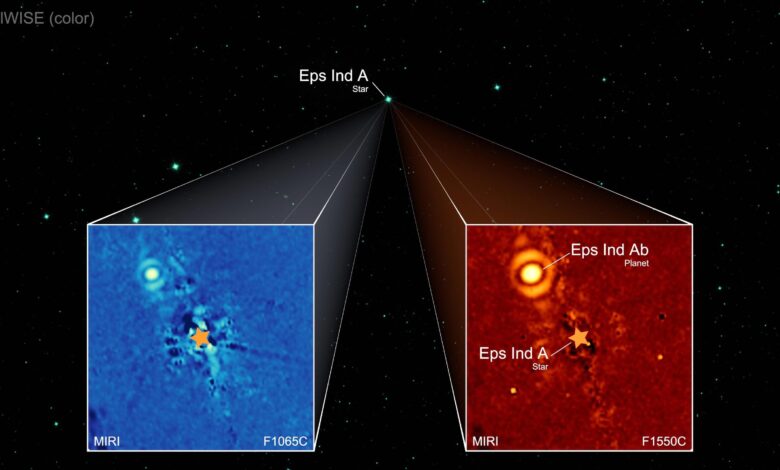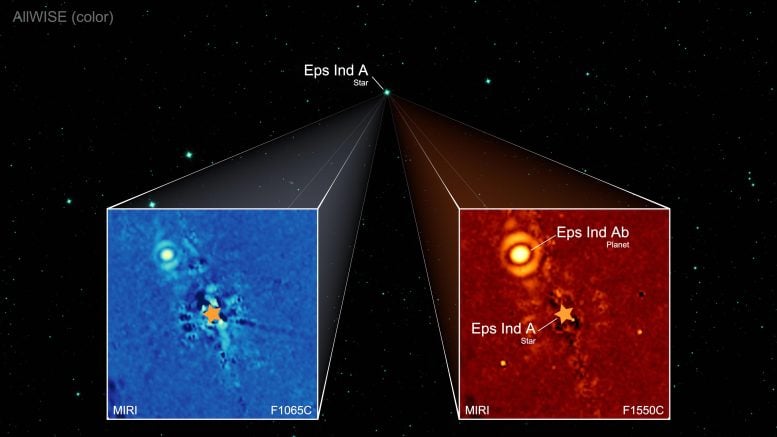Oldest and Coldest Exoplanet Ever Imaged


Only a point of light is visible on the JWST/MIRI images. Nevertheless, the initial analysis suggests the presence of a gaseous planet that may have properties similar to Jupiter. Credit: T. Müller (MPIA/HdA)
Researchers using the JWST have captured a new image of Eps Ind Ab, a super-Jupiter with an orbital distance significantly greater than previously estimated.
This discovery, highlighting a colder exoplanet than typically observed, prompts a reevaluation of its mass and orbit while also offering a new method for studying distant cold gas giants through direct imaging and spectral analysis.
Imaging a New Exoplanet
“We were excited when we realized we had imaged this new planet,” said Elisabeth Matthews, a researcher at the Max Planck Institute for Astronomy in Heidelberg, Germany. She is the main author of the underlying research article published today (July 24) in the journal Nature. “To our surprise, the bright spot that appeared in our MIRI images did not match the position we were expecting for the planet,” Matthews points out. “Previous studies had correctly identified a planet in this system but underestimated this super-Jupiter gas giant’s mass and orbital separation.” With the help of JWST, the team was able to set the record straight.
This detection is quite unusual in several aspects. It shows the first exoplanet imaged with JWST that had not already been imaged from the ground and is much colder than the gas planets JWST has studied so far. An ‘image’ means that the planet appears as a bright dot on the images and thus represents direct evidence. The transit and radial velocity methods are indirect evidence, as the planet only reveals itself through its mediated effect.

The inserts show cropped versions of the MIRI images obtained at mid-infrared wavelengths 10.65 (left) and 15.55 micrometers (right), which depict the area around the star Eps Ind A, whose position is indicated by star symbols. A coronagraph blocks the light from the star that would outshine both images. Instead, a new object becomes visible to the top left. This source is the exoplanet Eps Ind Ab. The background was obtained from the AllWISE sky survey. Credit: T. Müller (MPIA/HdA), E. Matthews (MPIA)
Overview of Eps Ind Ab’s Orbit and Characteristics
The planet revolves around the main component of the nearby triple star system Epsilon Indi, or Eps Ind for short. Astronomical labeling conventions assign the label Eps Ind A to that primary star, a red dwarf star a little smaller and cooler than the sun. To construct the planet’s name, a “b” is appended, resulting in the designation Eps Ind Ab.
The new JWST data are consistent with a super-Jupiter having a mass six times that of Jupiter in the Solar System. Eps Ind Ab orbits its host star on an eccentric, elliptical orbit whose farthest separation from Eps Ind A should range between 20 and 40 astronomical units. One astronomical unit is the mean distance between Earth and the Sun, approximately 150 million kilometers. The new values differ considerably from earlier studies, which is why the team chose to call this a “new” planet.
This zoom video begins with a wide-angle view of the sky centered on the star Eps Ind A. It ends with an image of Eps Ind Ab obtained with the MIRI imager of the JWST. Credit: T. Müller (MPIA/HdA), E. Matthews (MPIA)
Cool Planets, Hot Science
Only a few cold gas-giant planets orbiting solar-age stars are known to date, and these have all been inferred indirectly from radial velocity measurements. By imaging and taking spectra of the planets, astronomers can study their atmospheres and trace the evolution of planetary systems compared to computational models. Studying planets in fully settled planetary systems helps tie up loose ends concerning the late stages of planetary evolution and refine our general understanding of planet formation and evolution.
The recent observations lead the way to finding many more of these cold gas-giant planets. These will allow astronomers to study a new class of exoplanets and compare them to the solar system gas giants.
Challenges in Detecting Distant Exoplanets
However, these planets are hard to find using the classical detection methods. Planets far from their host stars are typically very cold, unlike the hot Jupiters that circle their stars at separations of only a few stellar radii. Wide orbits are highly unlikely to be aligned along the line of sight to produce a transit signal. In addition, measuring their signals with the radial-velocity method is challenging when only a small section of the orbit can be monitored.
Earlier studies attempted to investigate a giant planet orbiting Eps Ind A using radial velocity measurements. However, extrapolating a small part of the orbit led to incorrect conclusions about the planet’s properties. After all, Eps Ind Ab needs around 200 years to orbit its star. Observations over a few years are insufficient to determine the orbit with high precision.
Utilizing Advanced Technology for Direct Imaging
Therefore, the team around Matthews devised a different approach. They wanted to take a picture of the known planet using a method commonly known as direct imaging. Since exoplanet host stars are so bright, they outshine any other nearby object. Regular cameras would be overwhelmed by the blinding starlight.
For this reason, the team employed JWST’s MIRI (Mid-Infrared Instrument) camera equipped with a coronagraph. This light-blocking mask covers the star like an artificial eclipse. Another advantage is Eps Ind’s proximity to Earth, which is only 12 light-years. The smaller the distance to the star, the larger the separation between two objects appears in an image, providing a better chance of mitigating the host star’s interference. MIRI was the perfect choice because it observes in the thermal or mid-infrared, where cold objects shine brightly.
What Do We Know About Eps Ind Ab?
“We discovered a signal in our data that did not match the expected exoplanet,” says Matthews. The point of light in the image was not in the predicted location. “But the planet still appeared to be a giant planet,” adds Matthews. However, before being able to make such an assessment, the astronomers had to exclude the signal was coming from a background source unrelated to Eps Ind A.
“It is always hard to be certain, but from the data, it seemed quite unlikely the signal was coming from an extragalactic background source,” explains Leindert Boogaard, another MPIA scientist and a co-author of the research article. Indeed, while browsing astronomical databases for other observations of Eps Ind, the team came across imaging data from 2019 obtained with the VISIR infrared camera attached to the European Southern Observatory’s (ESO) Very Large Telescope (VLT). After re-analyzing the images, the team found a faint object precisely at the position where it should be if the source imaged with JWST belonged to the star Eps Ind A.
The scientists also attempted to understand the exoplanet atmosphere based on the available images of the planet in three colors: two from JWST/MIRI and one from VLT/VISIR. Eps Ind Ab is fainter than expected at short wavelengths. This could indicate substantial amounts of heavy elements, particularly carbon, which builds molecules such as methane, carbon dioxide, and carbon monoxide, commonly found in gas-giant planets. Alternatively, it might indicate that the planet has a cloudy atmosphere. However, more work is needed to reach a final conclusion.
Future Research Directions
This work is only a first step towards characterizing Eps Ind Ab. “Our next goal is to obtain spectra which provide us a detailed fingerprint of the planet’s climatology and chemical composition,” says Thomas Henning, Emeritus Director at MPIA, co-PI of the MIRI instrument, and a co-author of the underlying article.
“In the long run, we hope to also observe other nearby planetary systems to hunt for cold gas giants that may have escaped detection,” says Matthews. “Such a survey would serve as the basis for a better understanding of how gas planets form and evolve.”
Reference: “A temperate super-Jupiter imaged with JWST mid-infrared imaging” 24 July 2024, Nature.
DOI: 10.1038/s41586-024-07837-8
The MPIA scientists involved in this study are Elisabeth Matthews, Leindert Boogaard, and Thomas Henning.
Other researchers include Aarynn Carter (Space Telescope Science Institute, Baltimore, USA), Caroline Morley (University of Texas at Austin, Austin, USA), and Prashant Pathak (Indian Institutes of Technology, Kanpur, India).
The MIRI consortium consists of the ESA member states Belgium, Denmark, France, Germany, Ireland, the Netherlands, Spain, Sweden, Switzerland, and the United Kingdom. The national science organizations fund the consortium’s work – in Germany, the Max Planck Society (MPG) and the German Aerospace Center (DLR). The participating German institutions are the Max Planck Institute for Astronomy in Heidelberg, the University of Cologne, and Hensoldt AG in Oberkochen, formerly Carl Zeiss Optronics.
JWST is the world’s premier space science observatory. It is an international program led by NASA jointly with its partners, ESA (European Space Agency) and CSA (Canadian Space Agency).



